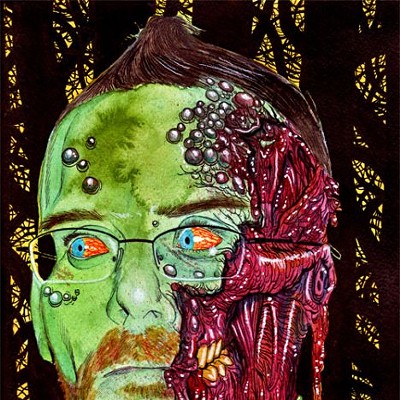We spoke to Henenlotter to get his thoughts on the films enduring popularity, its equally strange sequels and how the movie helped launch a new business model for horror films.
See also: From Basket Case to Raiders, the undying cult of genre film
Westword: When you were making this movie, did you have any idea it would be playing in theaters more than thirty years later?
Frank Henenlotter: Oh god no! In fact, just the opposite. The only reason I even finished making it was because I was convinced no one would ever see it. [Laughs] We originally wanted to do it with a budget of maybe $200,000 at least, so we could afford equipment and make it look a little good. We were able to raise zero dollars. So I started with my own money, which was $8,000. It was all that I had in the bank. Eventually the producer of the film, Edgar Ievins, he matched it with another $8,000 of his money. Then we were able to raise a little bit more here and there. But it was shot for $35,000, and I thought it was so shabby after a point that I had to switch emphasis from a more serious horror film to more humor. I had nothing else, you know what I mean? If you have nothing else, hype the blood and make everybody idiots.
There was a point where I was kind of dejected about it, thinking, "Well, it's not the script I wrote." But you don't abandon things once you start them. That's bad form, you know? We had already shot enough of it, so I just figured, let's go ahead, film it this way, and don't worry about it, because no one will ever see it. If we're lucky, it will play a week on 42nd Street, we'll make our money back. If it plays any other theaters it'll be skid row theaters like 42nd Street. No one will ever see the damn thing. And I am, to this day, still horrified. [Laughs] I'm proud and embarrassed that it's still playing, you know what I mean?
I was going to ask if your feelings about it have changed over the years -- sounds like maybe it has and it hasn't, at the same time.
Yeah, both. I cringed at how shabby some of it is, but I also realize that it's that shabbiness that audiences enjoy. But I'm still trying to make it look better. We shot it in 16mm, and when it was blown up to 35mm it was done so poorly and so badly that all the theatrical prints were terrible. They were so dark it looked like no one had lights in this film. It was terrible! I couldn't stand watching the film. That was the version that was originally released on VHS as well. It's just god-awful.
When digital tools came along, when you were able to remaster a film digitally, I was able to do a lot with it. I remember going to HBO studios and doing a digital master of it and going, "Oh my god, it's starting to look good." With what I was able to do with HD, it finally looks like what I shot in 16mm. It's still no beauty, but it's not as awful as it once looked. There's still no way I could fix all the shots. We were all just absolute amateurs doing it, so this is what it looks like. This is what it is.
For years we thought the negative was lost. It wasn't lost. It was hidden right under our noses in plain sight. When I found it, I was elated because I felt finally I can make the film look like it was meant to look, the way I shot it. We were able to do that, finally. The 35mm prints are not the film I shot. The HD master, what's out on Bluray now, is finally the film I shot. It;s taken, waht, thirty-odd some years for me to fix it, [laughs] but it's enough now that I can walk away from it and say, "It is what it is, but here's what I really shot." It may still suck, but it's there.
As an aficionado of b-movies, backyard auteurs and shitty movies in general, I'd say it actually looks pretty good.
Finally technology is where you can fix the mistakes of the past. I mean, it wasn't a mistake. What I did on HD was how it should have always looked. We must have paid for the cheapest blow up from 16mm to 35mm ever made. No care was taken with it. It added tons of additional grain and dirt on top of it. I was thrilled to finally get that off of it. I still wouldn't "fix" things in the HD master that have been with the film since day one. There's a clump of hair or dirt, something, when the detective is talking to Duane, and that was in it from the day we shot it. I will not take it out. Those pieces of dirt and jumps, all that kind of stuff, as long as they were built in to the negative, I won't touch it. They're as much a part of the flavor of the film as the actors and the bad special effects.
No Lucas-like fixes for you? We're not going to get a version where Belial is replaced with a CGI version?No. No. No. I don't think Belial would hold any charm any more. The power of the film, if it has any, or maybe the charm of the film, is that it does look like this tenth rate amateur production. It looks like a lot of the movies teenagers made in their backyard. The kind of stuff I was doing back then, you know? It's just a slightly more elaborate one. [Laughs] And one that got a commercial release. But I think it has the charm of a backyard, homemade movie, and I think that's what audiences like about it, I guess. I'm not really sure what audiences like about it. I'm always a little baffled by that, myself.
Something's kept it alive. Maybe it was released as just the right time, when cable was becoming popular and those movie channels needed something to play late at night? That's where I first saw your films.
If I can brag about something, Basket Case was one of the very first sell-through movies. Back in the day when the market didn't have sell-through prices. On VHS, it was released by Media Home Entertainment. When it first came out it sold for, I think, $49.95. I thought that was too high a price for the market, which was kids who read Fangoria. After it was out for a year, I was reading in Variety that Media Home had this crazy plan, this ridiculous concept of lowering the prices on a bunch of films to $19.95, thinking they could sell them outright. I thought it was a genius idea.
I saw the other films they had, the films they were going to put out, I thought they couldn't give away. I thought, boy, if I could get Basket Case in there... So I first had to convince the producer, Ievins, who was horrified. He thought, well we're going to cut our royalties to a third. I went, "Yeah, but we'll make that up in volume." I was convinced that we would. Media Home Entertainment was not. They were very annoyed. They were like, "We'll try it, but if it doesn't work for the first three months, we're going to go back to the original price." So in the summer, July 1984, Basket Case was released at $19.95 and sold out immediately. It did so well that Media all of a sudden got behind it. They said, "If this summer, we're going to do this in October" and they blitzed all the mom-and-pop stores -- poster for it, this and that.
It went through the roof. It was the only reprehensible blood-and-gore film out there [at sell-through prices] and the market, I think, was the kids who were reading Fangoria. They couldn't afford $49.95, but they could all afford $19.95. And the film made a fortune for us. By the next year, everybody else saw it, so that following year, come Halloween, there were a couple of hundred sell-through horror films out there. But I always thought Basket Case helped create that market.
That longevity helped get the two sequels made, too, I imagine.
Yeah, yeah. They were different. I didn't want to repeat the same formula. I already made Basket Case, why redo it? If we're going to do part two, why not take it in a different direction? I know a lot of people weren't happy with that, but I was. I was thrilled to do the film. The last thing I wanted to do was have Duane and Belial in another sleazy hotel on another skid row street. Plus, they died in the first, but beyond that, there was no more story. They came to New York to kill the doctors. Now what do I do with them? I thought, let's make the scope bigger and get them in a community of similar individuals, like Basket Case invades Freaks. I was very happy with that.
Part three I wasn't happy with because it was rushed. The original script I wrote we had a lot of problems with. They were originally going to go out with it unrated, then changed their minds midway through and made it PG13. It was all about pregnancy -- that's what the whole theme of part three was, the biological mishaps of pregnancy. You wouldn't know it from what was turned out, because the company cut all that, cut eleven pages of the birth scene, which ran and ran and ran. That was the whole point, she was giving birth for a couple of days [laughs], and that was all gone. It wasn't the film I wanted to make. Whatever. That's the way it is.
For people who maybe are seeing Basket Case this weekend, what would you tell them to keep in mind while watching it?
This is the fun you can have doing a movie without any money, whatsoever. When you've got nothing to work with, let's do some other things. [Laughs] Let's make it funny. Let's make it bloody. Let's have a good time, but don't expect this to behave like any other movie.
And for fans who've seen it many times over the years, what about for them?
This is the way you should have seen it from day one. It's going to look totally different. Well, not totally different, but quite a bit different.











